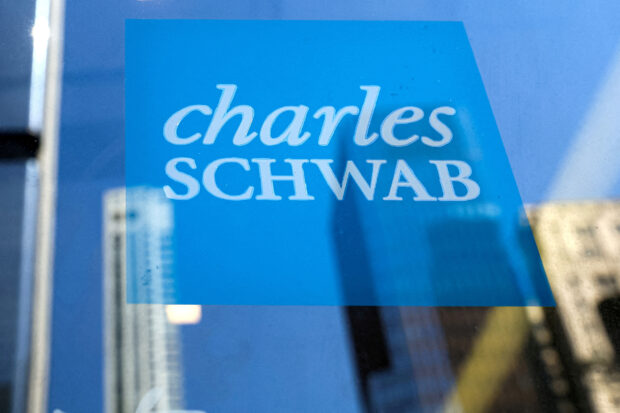US bank profits fall as competition for deposits erodes lending margins

The company logo for Financial broker Charles Schwab is displayed at a location in the financial district in New York, U.S., March 20, 2023. REUTERS/Brendan McDermid/File photo
NEW YORK -Several large U.S. regional banks reported lower profits on Wednesday, in a further sign that the income boost from interest rate hikes by the Federal Reserve is starting to wane.
Charles Schwab, Citizens Financial and US Bancorp said that, along with one-off charges, the rising cost of retaining customer deposits ate into fourth-quarter net interest income (NII), the difference between what banks earn from lending and pay on deposits.
Fed rate hikes last year aimed at taming inflation boosted many lenders’ NII, a core business for most regional banks. But growing competition for deposits from the country’s biggest banks is eating into their profits and in some cases subduing loan growth.
Big banks have benefited from an exodus of deposits from small institutions, which were seen as riskier, after Silicon Valley Bank and two other regional lenders collapsed last year.
Potential Fed rate cuts this year will likely further dent NII, some banks have warned.
Article continues after this advertisementNet interest income down
Charles Schwab’s quarterly profit fell 47 percent, partly due to a 30-percent drop in NII on higher deposit costs. Schwab paid an average of 1.37 percent on deposits, compared to 0.46 percent a year earlier, it said.
Article continues after this advertisementCitizens reported a 71-percent decline in profit, with NII down 12 percent. US Bancorp’s profit fell 14 percent as NII dropped 4.2 percent. On Tuesday, PNC Financial, another big regional lender, said profits shrank, with NII contracting 8 percent.
Citizens warned that its NII this year could be 6 percent to 9 percent below the $6.24 billion it made in 2023. Shares of Charles Schwab dropped 1.3 percent, US Bancorp fell 1.7 percent, while Citizens was up 1.9 percent.
“For banks, loan demand would be fairly tepid through the first half of the year, and then start to pick up again in the second half,” Citizens Financial CEO Bruce Van Saun told Reuters in an interview on Wednesday.
At 11 U.S. regional banks with assets of $50 billion to $100 billion, analysts expect earnings per share to drop from 2023 mostly due to increased deposit costs, according to LSEG estimates, Reuters previously reported.
The KBW regional bank index was last down 1 percent, in line with the broader market. Still, it is up about 10 percent since March when the industry crisis erupted, and some analysts think the sector remains attractive despite NII declines.
“It seems logical that the recent trend higher in share prices is met with near-term turbulence (from both NII softness and normalizing credit trends) – however, we believe the regionals remain attractive over the next 12-18 months as we fully price in the 2025 outlook,” Citi analysts wrote.
As with the largest U.S. lenders which reported earnings on Friday, regional banks also took big one-time charges to replenish the Federal Deposit Insurance Corporation’s (FDIC) deposit insurance fund, which was dented by the crisis.
JPMorgan, Bank of America, and Citigroup posted lower profits on Friday, in part due to lower NII.
Executives at these top banks were generally upbeat on the economy, noting American consumers remained resilient even as defaults on consumer loans are returning to pre-pandemic levels.
Rate cut watch
But major questions hang over markets, including whether the economy will avoid a recession and, as inflation eases, when the Fed will start to cut rates. Strong U.S. retail sales data on Wednesday showing the economy on a solid footing cast further doubt over market expectations of a Fed rate cut in March.
“I am a little on the cautious side,” JPMorgan Chief Executive Jamie Dimon told CNBC on Wednesday when asked about the U.S. economy.
Speaking to FOX Business Network’s “Mornings With Maria” at Davos on Wednesday, Bank of America CEO Brian Moynihan said the daily debate about where the Fed will take rates continued to create uncertainty for consumers and businesses.
“When the Fed’s done, then the capital markets reopen. Then people say, OK, 3.5 percent to 4 percent unemployment rate. I got my job, I got my wages, you know, things settle in.”